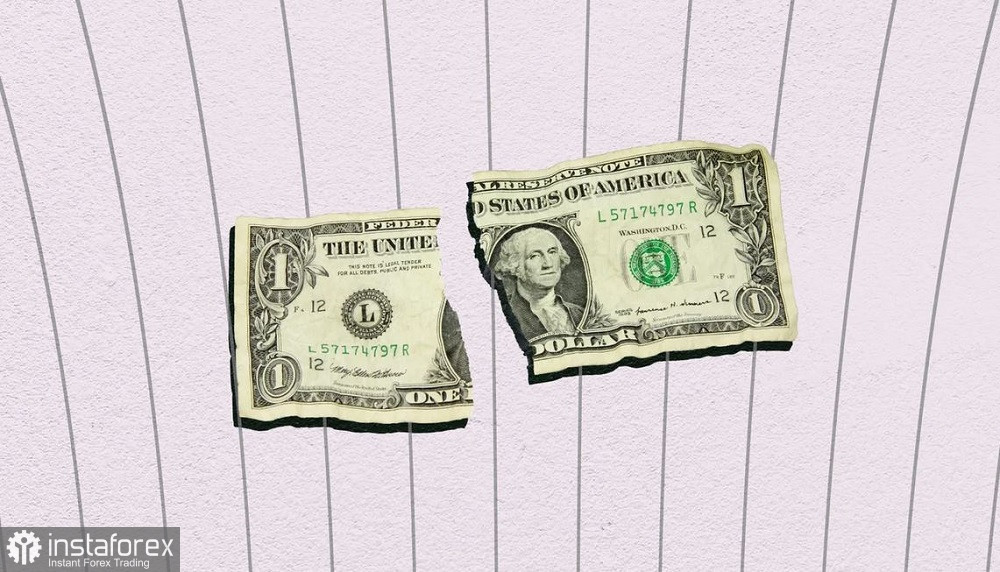The record surge in Treasury yields only offered temporary support to the US currency. The widespread movement of capital from the stock market to government bonds has driven yields to record levels. For instance, the 10-year yield has approached the 5% mark, its highest rate since March 2007. Other bonds are also breaking records, with the 5-year rate at 4.9% and 30-year rate surpassing 5%, the highest in 23 years. The risks of an additional rate hike from the Federal Reserve strengthened last week after the release of US inflation data. Despite the mixed nature of the reports (on one hand, both the Producer Price Index and the general Consumer Price Index are accelerating, and on the other hand, the core CPI and the core PCE index are falling), Treasury yields have been rising at a rapid pace.
And although Treasury yields rise and Wall Street incurs losses (investors reacted negatively to the corporate earnings results for the third quarter), the EUR/USD pair continues to trade within the 5th figure. In other words, it has been trading in the same range for the second consecutive week.

The Fed played a significant role in this context, particularly through some of its officials. Specifically, two members of the Fed (Harker and Bostic) suggest holding rates steady again. Their statements were quite straightforward. For example, Patrick Harker, the President of the Federal Reserve Bank of Philadelphia, who has voting rights this year, stated that the Fed should not at this point be thinking about any increases, as it could create new pressures in the economy. He also noted that the current Fed policy is weighing on the real estate market, as higher rates discourage current owners from listing their homes for sale. Parker believes the US central bank is likely done with its cycle of interest rate hikes.
Raphael Bostic, the President of the Federal Reserve Bank of Atlanta, voiced a similar position. Bostic laid out a case against any further U.S. interest rate hikes, saying monetary policy is "restrictive," just as it should be to bring U.S. inflation back to the 2% target.
Other Fed officials who spoke this week made more nuanced statements. For example, Michelle Bowman acknowledged that while inflation is gradually decreasing, it remains at too high a level. Her colleague, Christopher Waller, indicated the central bank can afford to watch and see what happens before taking further action.
Amid such statements, the market thinks the Fed has probably reached the top in the current tightening cycle. In particular, economists at Commerzbank still do not expect additional rate hikes. They believe that the first rate cut will happen at the beginning of the third quarter of 2024.
Markets were pricing in a 6% chance of another rate hike in November, according to the CME Group's FedWatch tool. As for the December meeting, the probability of a 25 bps rate hike is much higher, at nearly 40%. This suggests that the market has essentially priced in a status quo for the next month, but chances of tightening monetary policy at the December meeting are still on the table, roughly assessed as 50/50.
This disposition allows the dollar to hold its ground against the euro. However, the pair needs an appropriate impetus to establish a firm downtrend. Similarly, in order for the pair to correct higher, it needs a trigger to fall to the 1.04 range or rise above the 1.0600 level.
Fed Chair Jerome Powell, who spoke at the Economic Club of New York, or geopolitical events (such as an escalation in the Middle East) could tilt the balance one way or the other. If Powell aligns with the dovish Fed officials and takes a cautious stance (emphasizing the decrease in core CPI and the Personal Consumption Expenditures index while ignoring the rise in the overall CPI and PPI), the dollar may come under pressure. The bulls could then test the resistance level at 1.0630 (the upper Bollinger Bands line on the daily chart). But if Powell suggests another rate hike, the likelihood of a rate hike in December will increase. In that case, the bears might have a reason to push the pair towards the 1.04 level.
When it comes to geopolitics, the focus is on the Middle East. Israel has not initiated a ground operation in Gaza, but there are no signs of de-escalation in the conflict. According to some reports, the Israel Defense Forces (IDF) are finalizing preparations for a large-scale operation. However, other reports suggest that Washington does not support the escalation scenario, as it is concerned about the escalating humanitarian crisis and the risk of the conflict spreading to other countries in the Middle East. Many military and political experts believe that in the coming days, the unfolding events will clarify which scenario will play out.
From a technical perspective, on the daily chart, the EUR/USD pair is positioned on the middle line of the Bollinger Bands indicator, which coincides with the Tenkan-sen line. Meanwhile, the Kijun-sen line and the Kumo cloud are below the Kumo cloud. This situation is characterized by uncertainty, and traders tend to take profits when the pair approaches the 5th figure or the boundaries of the 6th price level. The bullish scenario will come into play in case the price settles above the 1.0630 target (the upper Bollinger Bands line on the daily chart). To resume the downtrend, sellers need to consolidate below the 1.0450 level (the lower Bollinger Bands line on the same time frame).





















